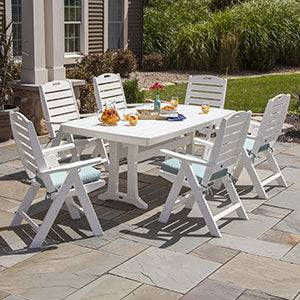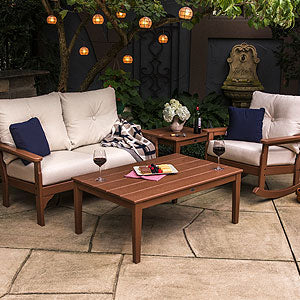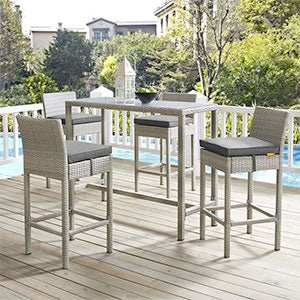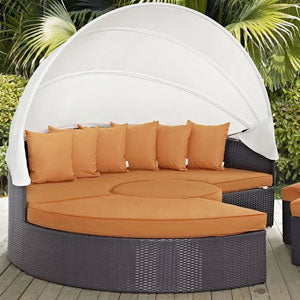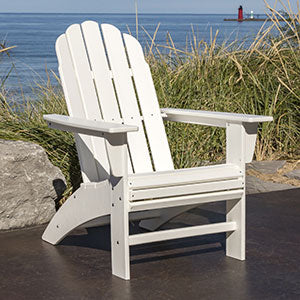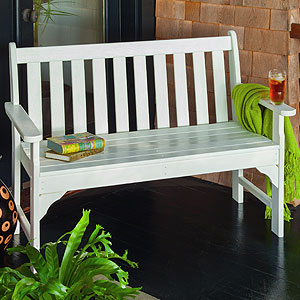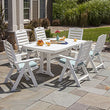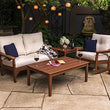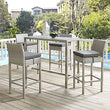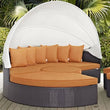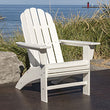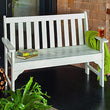Outdoor Living
Guide to Patio Furniture Cleaning and Storage
Keep Your Outdoor Furniture Looking Its Best
Buying furniture for your outdoor spaces is an investment, so you want your patio furniture to look its best and last for years of use and enjoyment. Regular cleaning is important to ensure your outdoor furniture looks good all year long, but is especially true after a long, messy winter. Before the summer season of outdoor living is upon you, it's time to do a little spring cleaning on your patio furniture to remove dirt, mildew, and debris, so it looks freshly clean and inviting to use. Here's some tips for the proper way to clean and maintain different types of outdoor furniture.
How to clean patio furniture
Regardless of the type of patio furniture you have, begin cleaning by dusting off any leaves, dirt, or debris that might have accumulated on any tables, chairs, loungers, or sofas that had been left or stored uncovered for any extended periods of time. You can use a dry cloth, a soft brush, or a shop vacuum to remove the loose dust and debris.
- Metal: Patio furniture can be made of a variety of metals. Stainless steel, wrought iron, aluminum, and tubular steel are common materials used due to their durability and strength. In most cases, all you need to restore metal furniture to pristine condition is to wash it in mild soap and warm or hot water, then dry it thoroughly by wiping with a dry cloth. Steel and iron can rust over time and are often painted or coated in rust-resistant finishes that will wear over time especially if exposed to weather extremes. If you see any wear, scratches, or chips in the painted finishes, use some steel wool to remove any rust or oxidation and repaint the furniture as needed.
- PVC, Resin, or Plastic: Outdoor furniture made of plastic, PVC, resin, or polyurethane is one of the easiest to clean and maintain. Since it is less expensive than other materials and comes in a wide range of styles, designs, and colors, it is a popular choice for lawn and deck furniture. You can use soap and water, any all-purpose spray cleaner and a sponge or damp cloth to clean it. You can also hose it down with a power washer for a deep clean in crevices. But skip any abrasive cleaners since they can scratch and dull surfaces.
- Teak, Wood, and Wicker: Although using a power washer is fine for plastic furniture, it is not recommended for patio furniture made of teak, wicker, or other types of wood such as ipa, acacia, pine, or mango. The high pressure of these washers can scar or damage the softer surfaces of the wood. To clean wood furniture, use a mild oil soap formulated for wood, or soapy water and a soft brush or cloth to remove dirt and grime. You can use a toothbrush to get deeper into the weave of wicker to loosen built-up dirt in the crevices. Dry the furniture thoroughly with a dry towel or cloth when done. Resist the urge to apply teak oil to hardwood furniture as it can encourage mildew.
How to clean patio cushions and fabric
Fabric seating and patio furniture cushions add color, style, and comfort to your furniture, but can get dirty quickly. Fabrics used in patio furniture can be made in a wide variety of materials including both synthetic and natural fibers. Some such as Sunbrella are more stain and moisture resistant and are easier to clean.
Whenever possible, consult the manufacturer's instructions for recommended cleaning methods. The safest method otherwise is to use a mild solution of dish soap and water or a solution of 2 teaspoons dish detergent mixed with ½ cup of borax in a bucket of water and a soft brush to scrub the fabric clean. Rain and humidity can leave fabrics damp and lead to mold and mildew developing. Although tempting, avoid using a bleach solution on mold and mildew since it can fade or damage the fabric. If soap and water does not entirely remove these stains, try a solution of white vinegar and water, then let the fabric air dry completely.
You can use your hose to spray the cushions down before using soap and to rinse them after scrubbing them down with your dish detergent solution. Some cushions have removable, zippered covers that can be machine washed on the gentle cycle. Always air dry your cushions to prevent shrinkage or damage from the high heat of dryers.
How to store patio furniture for winter
Although patio furniture is designed to be outdoors, fall and winter weather can damage your furniture if you don't take proper precautions. Always clean and apply any protective sealants if needed to your outdoor furniture before storing it away. If you have space in your garage or in a storage shed, you can store the furniture out of extreme winter weather conditions to best protect it, especially if you have wrought iron or steel furniture. Otherwise, you can leave it outside on your deck or patio and shield it from snow, rain, and icy conditions by covering it with specially designed patio furniture covers. Another option is to cover it with waterproof tarps to help winterize it. Be sure you secure the tarps with bungees, polypropylene ropes, or tie-downs to prevent wind from blowing the tarps loose.
Make it a regular habit to clean your patio furniture at least two times a year, once in the spring before you begin using it in the warm weather and once in the fall before you store it away for the winter. With proper care and maintenance, your furniture should provide you with many years of comfort and pleasure in your outdoor living spaces.


